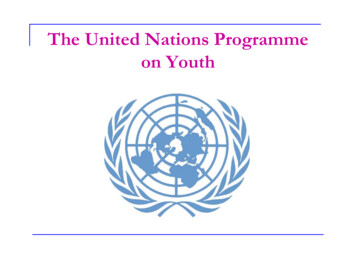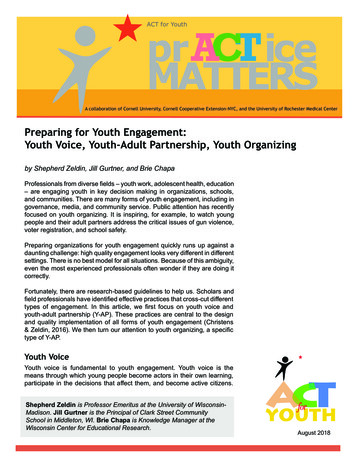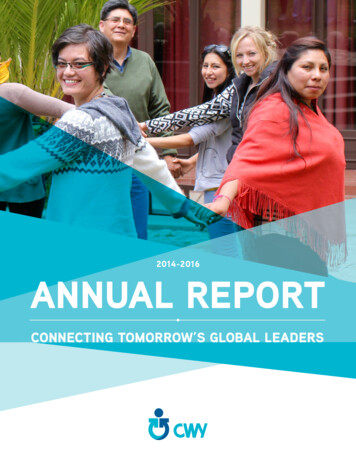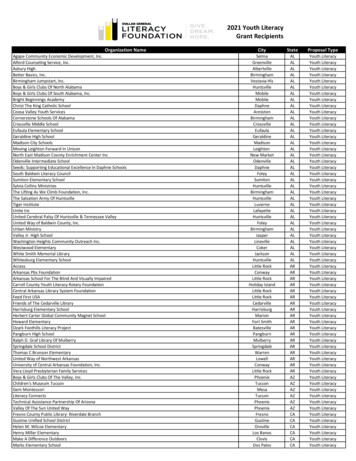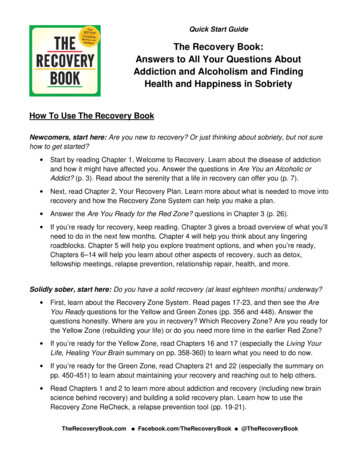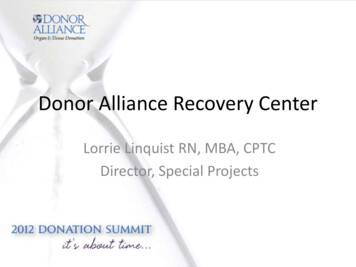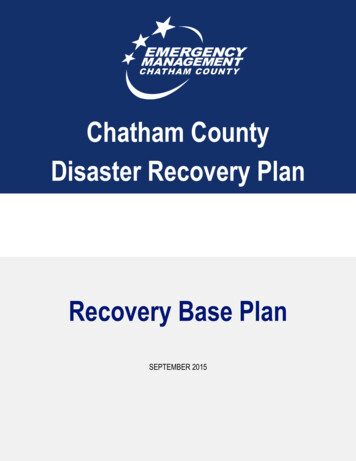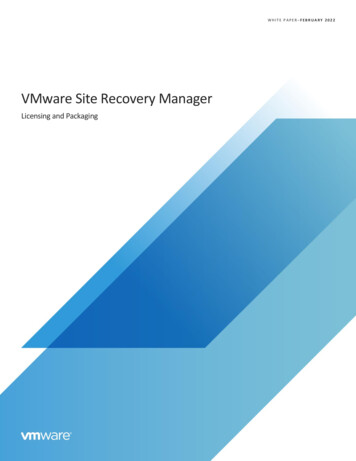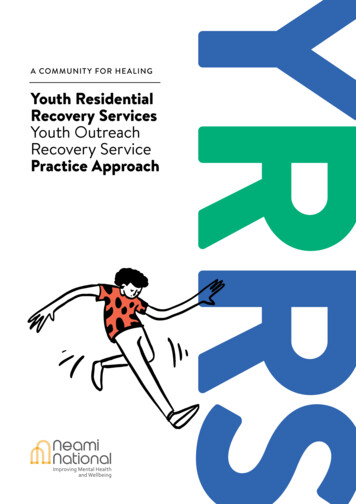
Transcription
YRRSA COMMUNIT Y FOR HE ALINGYouth ResidentialRecovery ServicesYouth OutreachRecovery ServicePractice Approach
PR E PA R E D BYRebecca Spies, Rebecca Egan, Grace McLoughlan, Cristal HallWITH CO NTR I B UTI O N S FROMYoung people and staff from Neami’s YRRSD E D I C ATI O N/ACKN OWLE D G M E NTThis report is indebted to the contributions of young people who have accessed YRRS/YORS,YRRS staff, and referrers who participated in interviews and focus groups with the reportauthors. We thank them deeply for the expertise and time they shared with us.CO N SUME R N A M E SNo names of consumers have been used and identifying details have been altered to protectthe identities of consumers whose experiences are shared here.SU G G E S TE D CITATI O NSpies, R., Egan, R., McLoughlan, G., & Hall, C. (2022). A Community for Healing.Youth Residential Recovery Service Practice Approach. Melbourne: Neami National.DESIGNDesign by GOZER Creative — gozer.com.auNeami acknowledges the Traditional Custodiansof the land we work on and pays its respects toElders past, present and emerging.Neami celebrates, values and includespeople of all backgrounds, genders,sexualities, cultures, bodies and abilities.EXECUTIVE SUMMARY5What are YRRS and YORS and who do they work with?5What has been achieved?6How has this been achieved?6WHAT ARE YRRS?9Youth mental health support9Youth Residential Recovery Services9What’s important in residential youth mental health care?12What are Neami YRRS?13The Neami YRRS practice approach14A team of people who care16Safe and satisfied staff17Who accesses YRRS?18Program Logic YRRS and YORS22WHAT IS BEING ACHIEVED?25Quantitative outcome measures explained28Stable accommodation for 12 months29Emotional and physical safety30Feeling known and belonging within a peer community36Building hope, skills and directions41I am becoming the expert of me51RECOMMENDATIONS54Resourcing what works54Strengthening through improvements55REFERENCES56APPENDIX58Evaluation method58
This document describes the practice andimpact of the Youth Residential RecoveryServices (YRRS – formerly Youth ResidentialRehabilitation Services) and Youth OutreachRecovery Service (YORS) delivered byNeami National and funded by the VictorianDepartment of Health.As a specialist community mental healthprovider Neami National (Neami) supportspeople’s agency to experience, achieve anddo things that matter for a fulfilling life - asguided by their strengths and values. Neamioperates in five states and one territory,and from over 60 service locations acrossAustralia, supporting over 27,000 individualseach year via services spanning communitymental health, residential mental health,suicide prevention and homelessness.This document outlines who accesses theYRRS and YORS, the approach that guidesteam practice and their ways of working,and the outcomes achieved by youngpeople through their engagement withthese services.What are YRRS andYORS and who dothey work with?YRRS are state-funded community mentalhealth programs that provide accommodationand intensive psychosocial support to youngpeople aged 16-25 who have significantmental health challenges.YORS is a supplementary model, introducedin 2021, to provide support to youngpeople aged 16-25 years with mental healthchallenges pre and post entry to a YRRS andas an alternative to a YRRS placement.More than housing or outreach support,the YRRS and YORS are spaces to resetfoundations, which can have lifelongimplications across many aspects of a youngperson’s life. Many young people enterthese services with a history of trauma andcomplex struggles that deeply affect theirsense of self and others. Young people area population doubly marginalised for theirage and their experience of mental healthchallenges (Delman, 2012), and traumahistories can compound disenfranchisement.YOUTH RE S IDENTIA L RECOVERY SERVICE YOUTH OUTREACH RECOVERY S ERVICE PR ACT ICE APPROACHYO UTH R ESIDENT IAL RECOVER Y SERVICE YOUTH OUTREACH RECOVERY S ERVICE P RACTICE A P P ROAC HEXECUTIVESUMM ARYIn recognition of this context, YRRS andYORS support is centred around empoweringyoung people through real relationshipswhich can change their sense of hope andpossibility in significant ways. YRRS and YORSare important steps in a journey to healing.45
6Certain types of support at certain pointsin the lifespan have genuine transformativeimpact. The YRRS is one of these. YRRSengagement does not eliminate distress– an impossible goal – but it provides asafe, secure space for young people tofeel supported as they do the hard workof recovery and healing. As young peoplefoster a sense of self-worth, they buildnew relational templates and transformtheir sense of hope and possibility. Throughdiscovering or reconnecting with theirstrengths and values, young people areseen, valued, and celebrated for who theygenuinely are, something some young peoplemay not have previously or consistentlyexperienced.This basis of relational safety in bothYRRS and YORS enables other importantoutcomes: Improved sense of connection andbelonging Increased independent living skills Deeper sense of meaning and purpose Improved psychosocial functioning Young people become the expertsof themselvesHow has this been achieved?YRRS offer a unique combination of longerterm psychosocial and residential supportto cultivate a sense of home, community,and healing. YORS extends this relationalapproach across transition periods and intothe community.Trauma-informed, developmentallyappropriate support is delivered by a teamwith interdisciplinary backgrounds in line withthe Collaborative Recovery Model (CRM)and the Egg Model, and their key constructs,described below.Change occurs across an evolving YRRSjourney. Support domains shift in and outof focus over time as young people and staffengage in a dance of support, choreographedto the young person’s needs and values.YRRS support is delivered in recognitionthat it is the staff’s workplace, but the youngpeople’s home. This home is a dynamic milieuwhere the needs of all members must becared for. The result is a peer communitydefined by relationships of care and mutualsupport.CRM MODE LEG G MO D E LCollaborative, relational coaching stanceReal relationshipsEcological systems perspectiveFeeling safe, known, and belongingFoundation of human rightsBuilding skills and directions for my futureValuing diverse knowledgesBecoming the expert of me YRRS YOUTH OUTREACH RECOVERY SERVICE PRACTICE APPR OACHYO UTH R ESIDENT IAL RECOVER Y SERVICE YOUTH OUTREACH RECOVERY S ERVICE P RACTICE A P P ROAC HWhat has been achieved?7
8Youth mentalhealth supportYouth ResidentialRecovery ServicesAdolescence and early adulthood aredynamic periods marked by social, emotional,and vocational development. They are alsoperiods when the emergence of mentalhealth challenges commonly occurs(McGorry et al., 2013). Reflecting thespectrum of severity and need amongst thiscohort, a suite of service offerings is availableto young people, and where appropriate, theirfamilies/carers/supports.YRRS sit at the more intensive end ofthis spectrum and through the provisionof a mental health recovery service in aresidential setting, represent a unique serviceoption for young people aged 16-25 withsignificant mental health concerns. Despitetraditional connotations linking the originalYRRS descriptor ‘rehabilitation’ with alcoholand other drug (AOD) supports, YRRS arenot withdrawal or treatment programs. Whilstmany young people engaging with YRRS dohave co-occurring AOD issues, AOD supportis a component rather than the focus of therecovery-oriented care provided. Unlike localtherapeutic residential care models, YRRSeligibility is not dependent on involvementwith statutory services (McLean, 2018). Themental health focus of YRRS differentiatesthem from vocational/education-centredYouth Foyers. And young people with acutemental health needs are often supported inclinical settings such as hospital inpatientunits or short-term Youth Prevention andRecovery Care services (YPARCs), whichdiffer to YRRS in that they provide shortterm (up to 28 days) integrated clinical/psychosocial support (Green et al 2019).As such, psychosocial residential supportalternatives that offer medium- to long-termmilieu-based recovery-oriented support foryoung people experiencing mental ill-healthare relatively unique.Whether they operate in community-based,outreach, or residential settings, mentalhealth services exist alongside education,vocation, alcohol and other drug, and outof home care services to support the holisticneeds of young people.Mental health services range from lowintensity/early intervention supports suchas primary health, school-based, and digitalsupports, to progressively more intensiveofferings such as headspace and publicly andprivately funded clinical supports, to moreintensive services that provide inpatient orresidential therapeutic care.YRRS YOUTH OUTREACH RECOVERY SERVICE PRACTICE APPR OACHYO UTH R ESIDENT IAL RECOVER Y SERVICE YOUTH OUTREACH RECOVERY S ERVICE P RACTICE A P P ROAC HWHAT ARE YRRS?9
10“ YRRs stand out as offeringsomething extremely uniqueand valuable” (R E FE R R E R)HeadspacePrivate Psych/PsychologistYORSYMCAOnline forumsYouth FoyerYSASPsychiatric UnitYPARCYRRSN UMB ER O FR E S I D ENT SAG ESU PP O RTMO D ELNE A MI Y RRSHelplinesPHNsD U R ATI O N O FSU PP O RTS TA FFI N GThis table compares the eligibility and support structure of the ResidentialYouth Services. The YRRS offer a unique approach to support focusedon mental healthELIG I B I LIT YCR ITER I ACAMHS/CYMHSSchool programsFI G U R E 2. R E S I D E NTI A L YO UTH S E RV I CE S I N V I C TO R I AOdyssey HouseCrisis Accomodation/supportExperiencingmental ill-health/psychologicaldistress.Commitment toparticipating inYRRS programUp to14 hours/day, with oncall on siteYOUTH FOY E RO UTR E ACHR E S I D E NTI A LCOM MU N IT YMENTA L H E A LTH – N O N CLIN IC A LMENTA L H E A LTH – CLIN IC A LVO C ATI O N A N D ED U C ATI O NRisk ofhouselessnessCommitment toengaging in workor study24 hrs2 yearsA LCO H O L & OTH ER D RU G S‘AdvantagedThinking’ toidentify andcultivatecapabilities andindependence16-24/25dependingon site16-98unitsdependingon siteIntegratedclinical andwellbeingsupport witha focus onrecovery,therapeuticenvironment,and familyengagement16-2510-20,dependingon siteOTH ERYRRS YOUTH OUTREACH RECOVERY SERVICE PRACTICE APPR OACHYO UTH R ESIDENT IAL RECOVER Y SERVICE YOUTH OUTREACH RECOVERY S ERVICE P RACTICE A P P ROAC HAcross Victoria there are 18 YRRS operatedby seven non-government organisations.There is considerable diversity in operationaland staffing models due to local need,accommodation type, and unique providerapproaches. Staffing presence can vary from12-24 hours and some providers collecta small service fee to contribute to utilities(State of Victoria, 2021).Y PARCFI G U R E 1. LO C ATI N G Y R RS & YO RS I N TH E S E RV I CE S YS TEMThe mental health service system is complex. It can be challenging tounderstand the different roles services play and just where they sit inrelations to other types of support. This figure maps out some key servicesavailable in Victoria to young people experiencing mental ill-health. Thecolours of the dots represent the focus of each service, and their positionindicates if they are residential, outreach or community-based services.Need for brief,intensive mentalhealth supportto preventhospitalization(step-up), or supporttransition frominpatient setting(step-down)24hrsUp to4 weeks11
12A clear picture is building in the literature(Thomson, McArthur & Winkworth, 2005;Bath, 2008; James, 2011; McLean 2018;Green et al 2019) of what’s importantin residential youth mental health care,including:What are Neami YRRS?Developmentally appropriate,recovery-oriented care underpinned by a coherent modelof support A strengths-based approach to tailoringsupport in recognition that trauma orother experiences may have impacteda young person’s development relativeto their age (SAMHSA, 2014). A recoveryorientation promotes hope, self-belief,agency, identity, and connection (Rayner,Thielking, & Lough, 2018). connected to other supports and services Youth-friendly approaches delivered by skilled and supported staff Participatory approaches which promoteself-determination to empower youngpeople as active agents in their care. Care isconnected, family-sensitive, holistic, hopeful,and considerate of the personal, systemic,and macro systems in which young peopleare nested (Hughes et al., 2018; Rayner,Thielking, & Lough, 2018). Young people’slived experience is honoured and they aresupported to use this to inform programdesign and delivery. individualised care in a place that feels like a home where safety, hope, and autonomyare centred.Neami’s approach draws on several keytheoretical approaches to deliver what’simportant, including:Trauma-informed careSupport is delivered in line with the coreprinciples of safety (including cultural safety),choice, collaboration, trustworthiness,transparency, and empowerment (Fallot &Harris, 2009; SAMHSA, 2014). We honourthe healing potential of belonging, safety, andconnection through cultivating communitiesof real relationships in a homely setting(Rivard, Bloom, McCorkle, & Abramovitz,2005; McLoughlin & Gonzalez, 2014; Pecora& English, 2016; Smith & Spitzmueller, 2016).Attachment theoryEarly experiences of care have lastingimpacts on engagement styles. Youngpeople can develop new relational templatesthrough restorative relationships attunedto their needs. Neami National runs 4 YRRS in metropolitanMelbourne, supporting up to 38 youngpeople at a time. Young people live on sitewhilst participating in the program for aperiod of up to 12 months. These youngpeople present with a range of mentalhealth concerns including but not limitedto severe anxiety, depression, PTSD, andearly psychosis, with many having historiesof complex trauma.Young people also attend twice-weeklyindividual support sessions with an allocatedsupport worker. During their time in theYRRS, they work on key areas of selfdevelopment to support them to feel capableand confident to live a life of self-determinedmeaning and purpose.The accommodation may be a cluster ofone- or two-bedroom units or a singledwelling with up to 10 bedrooms and sharedcommunal spaces. They are staffed for upto 14-hours per day by support workerswho deliver strength-focused supportthrough structured group programs andindividual coaching. The structured routineincludes morning check-in and a weekdaygroup program collaboratively developed bystaff and young people. Weekends regularlyfeature excursions including bushwalkingand shopping. Understanding behaviours and emotionsThe group program encompasses topics ofhealth and wellbeing, independent daily livingskills, psychoeducation, self-development,employment, education, communityconnections, socialising, and recreation.Some areas of self-development can include: Self-responsibility Self-care Enhanced coping skills Independent living skills.The YRRS program may also assist youngpeople to develop and maintain linkswith their local community, family, socialnetworks, and support them to pursueeducational and vocational opportunities.The YRRS are facilitated through The EggModel and the Collaborative RecoveryModel (CRM).YRRS SummaryYRRSThe support 18 YRRS Funded by the VictorianGovernment’s Department of Health Staffed for up to 14-hours per day Neami operates 4 metropolitanMelbourne sitesNeami YRRS Capacity to support up 38 youngpeople at a time Eligibility 16-25 with significantmental health concerns Young people live on site forup to 12 months Strengths focused support Facilitated through The Egg Model andthe Collaborative Recovery Model (CRM).YOUTH RE S IDENTIA L RECOVERY SERVICE YOUTH OUTREACH RECOVERY S ERVICE PR ACT ICE APPROACHYO UTH R ESIDENT IAL RECOVER Y SERVICE YOUTH OUTREACH RECOVERY S ERVICE P RACTICE A P P ROAC HWhat’s importantin residential youthmental health care? Structured routine including morningcheck-ins and weekday group program Regular weekend excursionsThe group program and individual support Developed collaboratively betweenyoung people and staff Twice-weekly individual support sessionsto support self-development13
Young people need flexible support overtheir year in the residential setting thatis characterised by three key factors:A SHELLsupports and protectsA MEMBRANEcushions and allows growthEGSAFEbuig o alsandonI amFEELINYO UTH R ESIDENT IAL RECOVER Y SERVICE YOUTH OUTREACH RECOVERY S ERVICE P RACTICE A P P ROAC HThe CRM is Neami’s theoretical frameworkto support the delivery of trauma informed,culturally responsive, diversity appreciativepractices using cross-disciplinary expertise.The CRM offers an ethical, human, andrelational foundation for practice, wherediverse knowledges are celebrated, andthe unique contexts -both enabling andconstraining- people are nested in areexplored. The CRM assists young peoplein their recovery journey by using a personcentred coaching approach. This approachsupports people to identify their valuesand goals, and to make progress towardsthem. Often this progress is assisted byconnecting with formal and informalcommunity supports.ut my dire c t iIPLRE L AT I O N S HSThe Egg ModelThe Egg Model is a co-produced theoreticalframework for the YRRS. Built upon the threelayers of an egg, it metaphorically captureswhat matters to young people at the YRRS,demonstrating how different componentscombine to allow healing to take place.At the centre of the egg is a nucleus –representing young people becoming theexperts of themselves. Young people cometo the YRRS determined to use their timethere to clarify their goals and directions,and to work towards building skills for whatthey want from their future. The environmentof the YRRS is imagined as the membranethat cushions and allows growth. Centralto this membrane is an environment thatallows young people to feel safe, feel theybelong, and feel that they are known. Themembrane is supported and protected bythe shell of real relationships. These realrelationships – with staff, other young people,and with people outside the YRRS – arecritical to creating a space that is protective,supportive, and allows for healing, in whichthe nucleus can grow at its own pace.1. A good transition means a great start:Young people need a warm, supportedtransition into the YRRS. Important tothis transition is receiving informationregarding the program, meeting the staff,and beginning to build a relationship allprior to entry.2. Dance of support – the right supportat the right time: Young people have afluctuating need for support over time.This is dependent on individual levels ofcoping skills, and points of crisis in theirlives. It is a dance between young peopledoing for themselves and staff doing for,and with, young people – a dance betweennot supporting enough and supportingtoo much. These relationships need tofind a rhythm, where the ultimate aim isboth people knowing the steps and ableto dance their part. It is not always thesame person that leads. Not every dancewill look the same as every dancer bringstheir own strengths and challenges, biases,values, prejudices, past experiences, andstages of development.3. Exiting with the skills and resourcesthey need: Timing is crucial in supportingpeople to develop the skills and tohave the resources they need for agood transition from the program. Exitplans need to be held in mind from thebeginning of the stay, so that skills canbe developed at the right time, and forlearnings to be consolidated. However,in order to have these discussions, youngpeople need to feel secure in the YRRS.For many, beginning to plan for housingneeds to happen early in the stay, andfor some young people, 12 months is notlong enough to heal from a life that hasinvolved much trauma and upheaval.Young people regard the YRRS as theirhome and feel strongly about creating andmaintaining a comfortable, safe space forthemselves. It is important to young peoplethat staff remember that although thisenvironment is their workplace, it is alsothe home of the young people. Changes,where they have no control, could be veryunsettling.Our home needs to workfor everyone.The YRRS are complex operating systemswhere staff are working to hold the wantsand needs of individual young people whilesimultaneously considering the needs ofthe whole group. This is a balancing actthat can sometimes feel unfair from theperspective of a single individual. It is alsoabout young people realising that livingtogether, and building relationship skills,involves compromise. Developing skills forcompromise and tolerance in relationshipsis a work in progress and for many youngpeople they require support from staffto achieve this balance.Understanding that ‘the work’happens all the time.For young people, the work of recoveryhappens all the time; in the small, everydayroutine activities, in conversations, inincidental moments, and planned structuredactivities. Every interaction has the potentialto become a teachable moment and helpequip young people with the skills andresources they need to live independently.YOUTH RE S IDENTIA L RECOVERY SERVICE YOUTH OUTREACH RECOVERY S ERVICE PR ACT ICE APPROACHThe Collaborative Recovery ModelgoNwThe Neami YRRSpractice approachkinKNOWreI AMBECO MINGTHE EXPE RTOF MEI amR14skills for mngy fuldituorEAAMGIgrows at it’s own pace when nurturedINA NUCLEUSELFEFELII B E LON GNGRecognition that it is thestaffs’ workplace but theyoung persons’ home.Research undertaken on the YRRS hasrevealed some guidance about whatstaff needed to know and do about theenvironment to create the shell andmembrane that can nurture healingand growth for all young people:15
A team of peoplewho careY RR S YOUT H OUTREACH RECOVERY SERVICE PRACTICE A P P ROACHStaff are trained in trauma-informedpractice, the Collaborative RecoveryModel, applied suicide prevention skills,working with Aboriginal and Torres StraitIslander young people, transgender andgender diverse inclusivity, and first aid.In recognition of the complex work they do,individual and group supervision providesstaff “a space for the grief and a space forsupport and a space for challenging anda space of reflection” (staff).Honouring the identities and livedexperience of staff fosters a culture ofauthenticity and relatability that filtersthrough the whole service. Through openlysharing their recovery stories, peer workerscan foster hope and possibility for youngpeople, demonstrating “we’re not here justspouting theory at them, we’re showingthem it is possible, recovery, whateverit looks like for you” (staff). The rolemodelling of peer workers in safe sharingalso supports a lived experience culturewhere all staff feel safe to discuss how theybring themselves to work and the impactsit has on them.In line with trauma-informed principles,the Egg represents a support frameworkfor young people and staff alike. Staffhighlight their own need for safety,belongingness and feeling known, withoutwhich burnout becomes a real possibility.A culture of learning and growing – whereeveryone is a work in progress – affirmsthe journey of each member of the YRRScommunity – and staff feel seen for theirstrengths, supported in their areas fordevelopment, held as they make mistakes,and encouraged as they take responsibility.16The service benefits of safe and satisfiedstaff are multiple. Intake processesimprove as staff shift their focus frommanaging risk to readiness and motivation.Relational trust develops with clinicalproviders and other service partners,which can streamline service pathwaysespecially during crisis. Staff retentionincreases, resulting in greater consistencyin the YRRS program, relationships, andculture. Victoria’s mental health andwellbeing workforce strategy 2021–2024identifies ‘Supporting the safety, wellbeingand retention of the mental health andwellbeing workforce” as one of its 4 priorityareas (State of Victoria, 2021). Over halfof the YRRS staff cohort have been withNeami longer than 3 years and the servicehas had a consistently low yearly turnoverrate of 3% or less over the past 3 years.This is particularly important as youngpeople are keenly attuned to staffinginconsistency, which can be destabilisingeither through broken relationshipsor uncertain program structure.STAFF QUALIFICATIONS:social work, psychology,peer work, youth work,occupational therapy, arttherapy, and alcohol andother drugs.STAFF ARE TRAINED IN:in trauma-informedpractice, the CollaborativeRecovery Model, appliedsuicide prevention skills,working with Aboriginal andTorres Strait Islander youngpeople, transgender andgender diverse inclusivity,and first aid.PEER WORKERS FOSTERHOPE AND POSSIBILIT YFOR YOUNG PEOPLE:“we’re not here just spoutingtheory at them, we’reshowing them it is possible,recovery, whatever it lookslike for you” (S TA FF).A culture of learning and growing– where everyone is a work in progressBenefits of safe and satisfied staff: Intake process improves Stronger relationships with clinical providers and service partners Consistency in YRRS program, relationships and cultureY R RS EM PLOY E E LE N G TH O F S E RV I CE A N D CU R R E NT RO LE54321YOUTH RE S IDENTIA L RECOVERY SERVICE YOUTH OUTREACH RECOVERY S ERVICE PR ACT ICE APPROACHNeami YRRS are delivered by a teamincluding a service manager, supportworkers, and peer workers, whosequalifications span social work, psychology,peer work, youth work, occupationaltherapy, art therapy, and alcohol and otherdrugs. This interdisciplinary approachcreates a care community where staff can“make decisions together about balancingindividual and collective recovery” (staff).Safe and satisfied staff0LESS THAN1 YEAR1–2 YEARS2–3 YEARSCRSW3–4 YEARS4–5 YEARSO PMG RPSW5–10 YEARSS WCTable created from Neami YRRS Employee Position Data as of 01-Dec-2021.Acronyms: CRSW – Community rehabilitation & support worker, OPMGR – Operational Manager/TeamLeader, PSW - Peer support worker, SWC – Other Support Worker or CoachYRRS staff retention data from January 2019 – December 2021Annual turnover rates over the last three years of 2.9% (2021), 3% (2020), and 2.4% (2019).17
Who accesses YRRS?YRRS support young people aged 16-25 who are experiencing a psychiatricdisability. For some young people, their hope in accessing the service “wasto stay alive” (young person – YRRS). Whilst concerns about mental healthand independent living skills are central, many referrals are prompted whena young person’s accommodation is jeopardised.FI G U R E 3. AG E/G E N D E R AT S E RV I CE E NTRY252423“ People are wanting a safe space to get away from their parentswho just don’t agree with who they are, whether they identify astransgender, or just a number of things, they’re not allowing thatyoung person to become an adult in the way that they want to be.Or the absolute rates of abuse and neglect that their parents areperpetrating” (S TA FF)Eligibility is not bound by location – young people can access a YRRSwithout living in its catchment area, although this may impact their ongoingeligibility with existing supports.Referrals can be made by clinical services, other professionals, youngpeople themselves or informal supports. They are processed through acentral intake function and assessed by a monthly review and triage panelwith YRRS managers, a Child and Youth/Adolescent Mental Health Serviceclinician, and intake worker. Young people are allocated to vacanciesaccording to their needs and the current YRRS site dynamic. A site-basedpsychosocial intake assessment explores the young person’s readiness andfit for the program. Some sites invite young people to write a letter/song/collage/picture before they move in about what they want to achieve tohumanise the process and encourage them to ‘own’ the referral rather thanthe referrer.Due to the unique residential nature of YRRS, the needs and dynamicof the whole YRRS community are considered during intake. This meansthat admission may vary according to acuity depending on the currentcohort at the YRRS. Whilst this enables access for young people acrossthe spectrum of significant mental health need, it can be experienced bysome referrers as an inconsistency in the terms of reference or favouritism.Whilst clarity is crucial to minimise such concerns, the relatively broadeligibility requirements may facilitate access for young people whose needsare frustratingly seen as either too acute or not acute enough for otherservices. The YORS program has been introduced in part to fill this need, byoffering young people the preliminary support that readies them for YRRSengagement.21YOUTH RE S IDENTIA L RECOVERY SERVICE YOUTH OUTREACH RECOVERY S ERVICE PR ACT ICE APPROACHY RR S YOUT H OUTREACH RECOVERY SERVICE PRACTICE A P P ROACH2220191817160510FE M A L E15202530I N D E TE RM I N ATE/I NTE R S E X35MALE40OTH E RGenerated from QDC data collected at entry to services between January 2018 – October 2021.We acknowledge that intersex people can be any gender, and that some genders and experiencesmay be invisibilised by the term ‘other’.FI G U R E 4. PR IM A RY D I AG N OS I SSCHIZOPHRENIA/SCHIZOAFFECTIVE DISORDERBIPOLAR DISORDERBORDERLINE PERSONALITY DISORDERPERSONALITY DISORDERDEPRESSIONANXIETYPTSDEATING DISORDEROTHER PSYCHIATRIC DIAGNOSIS02468101214161820Generated from QDC data collected at entry to services between January 2018 – October 2021.1819
20In 2021, the Youth Outreach Recovery Service (YORS) was introduced tocomplement YRRS. Funded by the Victorian Department of Health, YORSsupports young people for the 6 months pre and post YRRS engagement,as well as providing an outreach alternative to a YRRS placement. As withthe YRRS, young people aged 16-25 requiring psychosocial support andexperiencing mental ill-health, su
residential therapeutic care. Youth Residential Recovery Services YRRS sit at the more intensive end of this spectrum and through the provision of a mental health recovery service in a residential setting, represent a unique service option for young people aged 16-25 with significant mental health concerns. Despite
